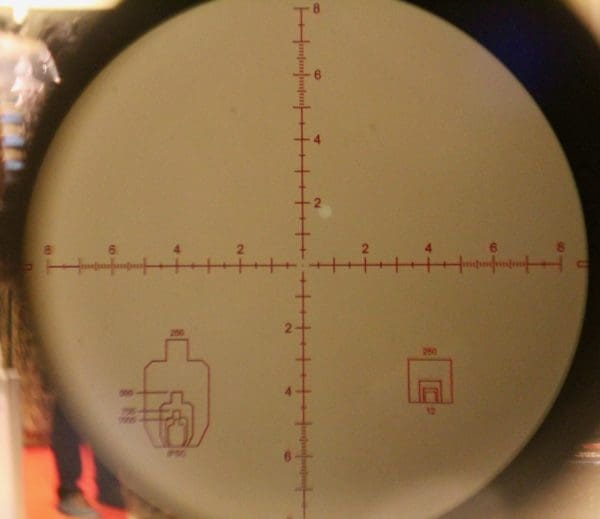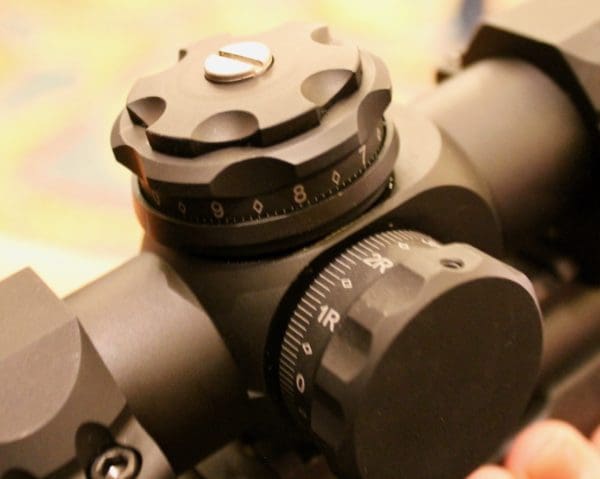
U.S. Optics has a reputation for making edgy, dare I say, weird scopes for the commercial and law enforcement markets. I have one of their LR-17 units on test right now and for the most part, it’s been a joy to use and shoot. I’ll save the full review for a separate piece. Imagine my frustration when I swung by their booth to see that they’ve discontinued most of their legacy lines including the LR-17, replacing them with an all new B series that offers better features paired up with a bit more user friendliness, all at a lower price.
Starting the line off is the B-10 series which will be a 1.8-10X optic with a 34 mm tube that includes their new locking turrets, tool-less elevation zero, and integrated illumination control. MSRP will be $1699 with real world pricing from our friends at OpticsPlanet at a shade under $1600. The B-10 will come with either the GAP-MIL or MOA Type 1 with a Horus H425 as an upgrade option.
Next up in the line will be the B-17, the 3.2-17X replacement for the LR-17 currently gracing my testing rifle. The B-17 goes to a 34 mm tube, up from the 30 mm in the LR-17. The B-17 can be equipped with the GAP, Gen II XR, MPR, and a host of Horus reticles – all illuminated. Adjustments are in 1/10 mil across the board and include the same locking and tool-less adjustment turrets from the B-10. MSRP is $2699 with street prices closer to $2500.

The last update is the to the highest magnification model, the B-25, a 5-25X magnification model that beefs up the capabilities of the B-10 and B-17 series by adding a bit more magnification, and the reticle you see above. That reticle is the PR2 which incorporates known size rangefinders in the lower quadrants. On the left is an etched outline of a standard IPSC torso with corresponding distances. On the right is a measurement scale based on a 12″ plate. Given that many precision rifle stages are doing unknown distance stages, this sort of thing could be immensely helpful in field expedient ranging conditions.
The B-25 includes illumination and the same knobs as the B-10 and B-17 models. I look forward to checking the PR2 equipped B-25 out at some point in the future. MSRP is $3249 with street prices at a shade over $3000 even. Adding a Horus reticle will bump the price $300 across the board.

Easily the most welcome change the B series brings is the move away from the slightly clunky EREK v1 knob to the EREK v2 system. One of the hallmarks of the U.S. Optics EREK system is the ability to independently adjust the internals to achieve maximum elevation travel. With the v1 EREK knob, you’d have to zero your rifle, rip the knob apart, fiddle with some hex keys, and then hope that you were just about on. And don’t get me started on setting a zero stop. If you happened to hold your breath and squint your eyes just right, it would work as intended. The rest of the time, it’d be a bit off.
U.S. Optics clearly understood the issue and moved to a tool-less EREK knob that allows the same range of adjustment with a much easier and more user friendly interface. More importantly, the turrets now lock in place by snapping them down, great for hunting and competition usage where a rifle banging around is the norm, not the exception.
I neglected to ask for test models simply because I haven’t finished my review of the outgoing LR-17. Once that’s wrapped up, I should have one of the B series in hand for further testing. So far, I like what I see.




That torso range finder is going to have a lot of moms demanding a lot of action.
Better than a crucifix crosshair reticle.
Since it’s a variable scope, do those range finding devices only work at a certain magnification setting?
First focal plane. So it works at all magnifications
OK, so you zoom in and they increase in size accordingly. Cool
Well if you’re going to be a day late and a dollar more might as well not innovate at all. This is the least exciting new scope offering in years. Way to blow it USO. This is why I converted to Vortex Razor II’s.
Comments are closed.